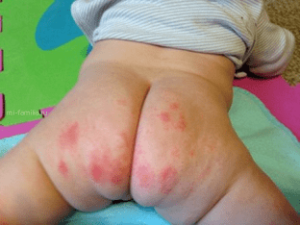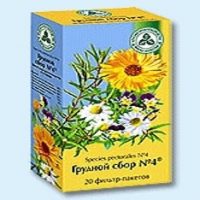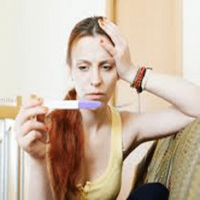 Almost every parent has to deal with diaper rashes, especially during the first year of your baby’s life. Many parents get very upset with diaper rashes and tend to feel that they have been negligent – which is just not the case.
Almost every parent has to deal with diaper rashes, especially during the first year of your baby’s life. Many parents get very upset with diaper rashes and tend to feel that they have been negligent – which is just not the case.
Diaper rashes is more common than you think, and is a part and parcel of childcare. Simple changes in the diapering routine will actually help prevent diaper rashes most of the times.
Why do diaper rashes occur
It is no rocket science as to why diaper rashes appear! A baby’s skin is super sensitive. Soiled diapers that are left for too long, or friction between the baby’s sensitive skin can cause redness and soreness on the bums. The skin can become tender, this irritation can cause rashes and make your baby uncomfortable. Some common reasons of diaper rashes are:
- Soiled or wet or moisture laden diapers that are left for too long on the baby cause irritation to the baby’s skin resulting in sore and scaly rashes
- Introduction of new foods to the baby which has changed the baby’s pee or poo frequency and composition actually changes the pH levels of the skin and becomes conducive for bacteria growth
- Chemical reactions with fragrances, detergents, powders, wipes, or lotions that you might be applying on your baby’s skin
- Bacterial or yeast infections caused due to the warmth and moisture in the diaper due to changes in the skin pH levels
Even if you are changing the diapers after only a few hours, the baby bums may still show reddening. This could be due to yeast called Candida albicans (a type of fungus)that results in a red, swollen rash with red dots towards the end. This usually happens if the baby or the breastfeeding mother are on antibiotics fighting some other infection. However, these antibiotics can cause the natural bacteria that fights off candida albicans to grow weak. Additionally, diarrhea only makes the rashes worse.
Treatments To Cure Diaper Rashes
- If your baby already has diaper rashes, you will need to take practical care. However, do not pat the skin withtalcum before setting up the diaper. Although it is perfumed, but it is still a mineral salt mixed with laboratory products. How can a ‘petroleum’ gel like Vaseline be good for the sensitive skin of the toddler?
- OTC creams and lotions can be good if they are not chemical based. Moms must be careful (and don’t panic please) because applying a lot of it at once may actually affect the highly sensitive skin. For choosing creams, look up actual reviews from parenting forums
- If the baby has candidal infection, anti-fungal creams or medicines may be recommended by the doctor. For bacterial infections, antibiotics may be prescribed
- Instead of using talcum powder (made of minerals), you can use corn starch powder. However, you must not use this remedy on yeast irritations. It can actually worsen the candida. Furthermore, corn starch will dry out the skin, so use it mildly and only when the condition is severe. Then, the infections will take in the impact, and the healthy skin will be okay. Also, when you are patting it, make sure that none of the powder is inhaled by the baby
- Breast milk is not only the perfect and complete food for the baby, but can also be the most inexpensive way to treat diaper rashes. Apply a few drops of breast milk on the baby’s red, sore skin and let the area air dry itself before you put on a new diaper
- See if you can find cranberries in your local markets for making juices. It is known as karamcha (Bengali)/Kalaakai (Tamil)/ Karimulai (Malayalam)/ Sushena (Oriya)/ kalive (Telegu)/ karamarda (Sanskrit)/ Karaunda(Punjabi) etc.
Precautions To Avoid Diaper Rashes
It may not be possible never to see your baby with a diaper rash, but a bit of attention and some precautions can help prevent diaper rashes largely. Below tips would be helpful:
- A dry bottom is your best bet against a diaper rash. Changing a diaper as soon as it get soiled is the right thing to do. Clean your baby’s bottoms thoroughly when changing a diaper. Also, never rub the baby’s bottom- always pat it dry. Never secure the diaper too tightly. Let the air circulate
- Intuitive mothers actually have to deal very less with this issue. Of course, you may be thinking that it is frankly impossible to understand when your baby is letting go body wastes. Everything is spontaneous in that little big world!
- Check out DBL or Dunstan Baby Language. Priscilla Dunstan is a mother with a keen sense of hearing. She identified common syllables that are used by toddlers to express their basic needs. If you can change the diaper in time, the rashes do not appear. Simple! Read more here
- Take note of the feeding pattern for your cues on diaper change. Any food in this age is a new experience for the toddler stomach. Do remember that the eating habits of the breastfeeding mom directly transpire to the baby. If you are drinking too much milk even, it can show up in gas issues for the kid
- Do not keep your baby in diapers all the time. The skin needs to breathe as well. Allow free air relaxation for the tiny King or Queen so that the skin does not feel uncomfortable from constant covering!
- Avoid fancy products to avoid diaper rashes. Even if the gel in a fancy diaper is absorbing the pee, it is still there. The chemicals of these gels also have side effects. These are good only in circumstances where you do not get to change the diapers often (for example, when going on an outing). At home, consider a diaper which is a size larger than the exact fitting.
- This will allow the comfort of air, and help you to take notice immediately of the need for diaper change
- Every time you change diapers, pat-wipe (not scrub) the skin cleanly. Remnants of poop or pee should not be adhering. Use mild soap occasionally. Also, do not set up the diapers on a wet skin. Special soft wipes are available to clean the skin of babies. Use the lint-free and non-alcoholic products
- Take care that your hands are clean before you begin changing your baby’s diaper. Always wash your hands post changing a diaper as well
Also try putting in the diaper slightly loosely so that the skin does not get brushed up and hence prevent chafing. Ideally, diapers should be changed every two hours, but if the baby has pooped, the diaper should be changed immediately.
Diaper Rashes With Cloth Diapers
A diaper is a diaper after all. Though cloth diapers are better in terms of breathability yet they also need to be changed frequently to prevent diaper rashes. You will need to be careful when washing the cloth diapers – use mild detergents and always run an extra rinsing cycle. Avoid using other chemicals like cloth conditioner or fabric softeners – a baby’s skin is too sensitive and can be easily irritated by any foreign particles. Dry the cloth diapers in the sun to kill any remaining bacteria.
Home Remedies For Diaper Rashes
Some home remedies that can help cure diaper rashes are:
- Baking Soda: The healing properties in baking soda can help treat a diaper rash as well. Create a mixture with 4 cups of water and 2 table spoons of baking soda. Every time you change your baby’s diaper, wash the area with this mixture. Lightly pat the skin dry with a dry washcloth. You can also mix 2 table spoons of baking soda in your baby’s bath tub and fill it with warm water. Bathe your baby in this water for 3 times a day, for about 10 minutes each time. Pat your baby dry and dress her up
- Petroleum Jelly: A lot of doctors advise to coat the baby’s bottom with a thin layer of petroleum jelly. It will keep the harmful bacteria from pee and poop from coming inc ontact with the baby’s tender skin
- Coconut Oil: Coconut oil not only has a soothing effect on any kind of rash but it’s anti-fungal and antimicrobial properties also make it a great moisturizer and an antiseptic. A tub of warm water can have some coconut oil mixed to give relief to your baby from diaper rashes
- Oatmeal: The chemical compound saponin, and the high protein content of oatmeal helps preserve the skin’s natural barrier that does not let unwanted particles to get inside the skin pores. Soak your baby for about 10 minutes in a mixture of a table spoon of dried oatmeal and with the baby’s bathing water twice a day to heal and prevent diaper rashes
- Vinegar: Vinegar is one of the best ingredients that can balance the skin pH levels. If you are using disposable diapers, administer a teaspoon to a cup of water making a weak solution and wipe your baby’s bottom with this when changing the diapers. Cloth diapers can be rinsed in a vinegar solution for maximum benefits
When to see a doctor:
If you are changing diapers on time, yet there are rashes or signs of irritation on the baby’s skin, you could see a doctor. When the rashes are severe, a good doctor will recommend products like anti fungal zinc oxide based ointments etc. Use these creams only in the minimum amount as after all they are chemicals!If your baby is running a fever along with rashes, or develops pus, reach out your pediatrician for treatment.









